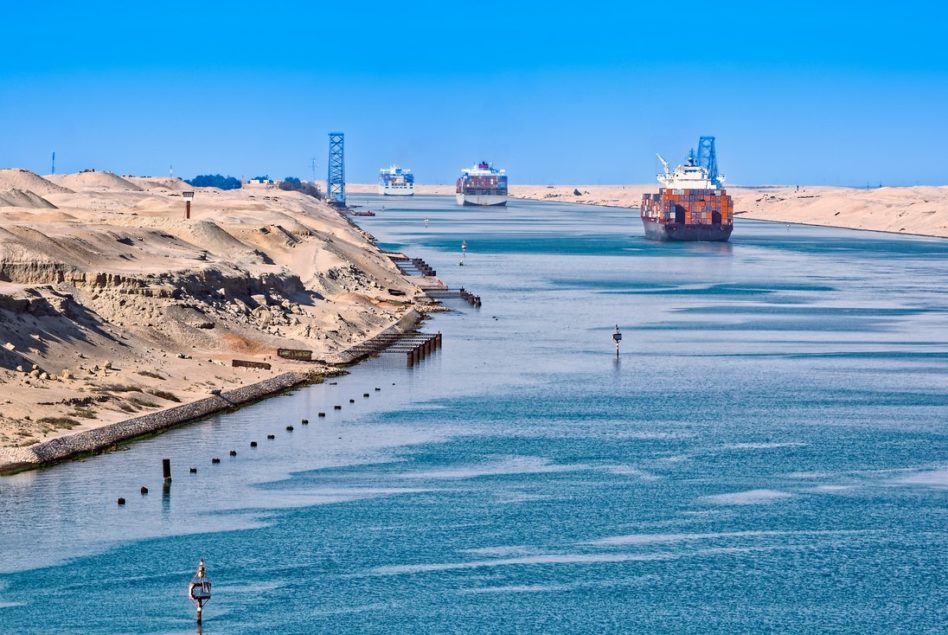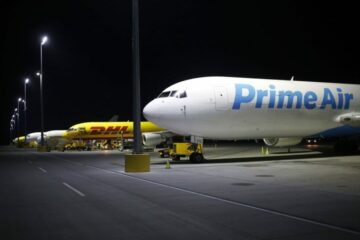
Every major commercial shipping line is rerouting vessels away from the Suez Canal in response to the recent series of missile attacks by Houthi militants in the Red Sea.
Their options are limited. Drought conditions at the Panama Canal have resulted in a temporary halt in commercial transits until May at the earliest. (Many of the containerships that regularly pass through the Suez Canal are too big to fit through the Panama Canal anyway.) That leaves passage around the Cape of Good Hope off South Africa, adding between seven and 14 days to total transit depending on ports served.
Some carriers prefer the longer route around the Cape of Good Hope because it avoids the Suez’s high tolls, which can approach $1 million for a 20,000 twenty-foot equivalent (TEU) containership, says Nathan Strang, director of ocean freight for the U.S. Southwest and SMB with Flexport. Rerouted ships burn more fuel, but still end up paying less for the voyage overall.
But the real issue around re-routing is the impact it has on total capacity in the oceangoing trades, Strang says. Longer transit times mean that carriers must add vessels to keep pace with demand. In theory, some of that shortfall can be mitigated because global containership services are currently in a state of overcapacity. “Freight rates are unlikely to spike to extreme highs due to the current high levels of available capacity,” Freightos says.
Still, says Strang, it’s not always possible to replace a 20,000-TEU ship, given the limited number of routes it can serve due to limitations on water depth and berthing facilities.
Even with the Cape of Good Hope option, the Houthi attacks in the Red Sea, reportedly originating in Yemen, are having a seriously disruptive effect on global shipping. According to Freightos, the Suez Canal accounts for around 30% of global container traffic, and more than a million barrels of crude oil per day. Even a temporary loss of that critical route is certain to result in higher freight charges. Ocean rates from Asia to Europe and the Mediterranean were already up 21% and 62%, respectively, in December, even before the announced diversions, according to Freightos. It estimates a 15%-20% rise in carrier costs due to longer transit times.
Vessel insurance costs, too, are likely to rise, at least for the duration of the attacks. (Because many policies do not cover acts of war, shipping lines will have to carry extra war risk policies, Strang notes.) And the ultimate impact will be on the price of consumer goods at the retail level.
Military action to counter the attacks is underway. The U.S. Department of Defense has launched Operation Prosperity Guardian to defend Red Sea shipping. The initiative is supported by multiple countries, including the United Kingdom, Canada, France, Italy, Spain, Norway and Bahrain. It supplements the existing Combined Task Force 153, part of a 39-nation naval partnership of maritime forces.
“It’s a lot of ocean, though,” Strang says of the Red Sea region. “Ships can cover a finite [area] defensively.” And even with military protection, “you’re going through a shooting zone. Most lines would probably take an extra seven days unless for specific reasons, such as the movement of critical goods.”
How long the crisis will extend into the new year, as well as its impact on the next round of service-contract negotiations between carriers and shippers, is uncertain. “The number one thing I’ve learned in working in this industry is that most predictions are wrong,” Strang says. “You don’t know what the next variable is going to be.”
In the near term, he says, carriers will be coping with the surge in cargo volumes that traditionally occurs just before Chinese New Year, as shippers rush to fill orders before factories shut down for the holiday.
- SEO Powered Content & PR Distribution. Get Amplified Today.
- PlatoData.Network Vertical Generative Ai. Empower Yourself. Access Here.
- PlatoAiStream. Web3 Intelligence. Knowledge Amplified. Access Here.
- PlatoESG. Carbon, CleanTech, Energy, Environment, Solar, Waste Management. Access Here.
- PlatoHealth. Biotech and Clinical Trials Intelligence. Access Here.
- Source: https://www.supplychainbrain.com/articles/38705-container-lines-rerouting-ships-away-from-suez-canal-in-response-to-red-sea-missile-attacks
- :has
- :is
- :not
- $1 million
- $UP
- 000
- 14
- 20
- a
- According
- Accounts
- Action
- acts
- add
- adding
- africa
- already
- always
- an
- and
- announced
- approach
- ARE
- AREA
- around
- AS
- asia
- At
- Attacks
- available
- away
- bahrain
- barrels
- BE
- because
- before
- between
- Big
- burn
- but
- by
- CAN
- Canada
- Capacity
- cape
- Cargo
- carriers
- carry
- certain
- charges
- chinese
- Chinese New Year
- commercial
- conditions
- consumer
- Container
- Costs
- Counter
- countries
- cover
- crisis
- critical
- crude
- Crude oil
- Current
- Currently
- day
- Days
- December
- Defense
- Demand
- Department
- department of defense
- Depending
- depth
- Director
- disruptive
- do
- Dont
- down
- Drought
- due
- duration
- earliest
- effect
- end
- Equivalent
- estimates
- Europe
- Even
- existing
- extend
- extra
- extreme
- facilities
- factories
- fill
- fit
- For
- Force
- Forces
- France
- freight
- from
- Fuel
- given
- Global
- going
- good
- goods
- Have
- having
- he
- High
- higher
- Highs
- Holiday
- hope
- HTTPS
- Impact
- in
- Including
- industry
- Initiative
- insurance
- into
- issue
- IT
- Italy
- ITS
- jpg
- just
- Keep
- Kingdom
- Know
- launched
- learned
- least
- less
- Level
- levels
- likely
- limitations
- Limited
- Line
- lines
- Long
- longer
- loss
- Lot
- major
- many
- Maritime
- May..
- mean
- Mediterranean
- Military
- million
- more
- most
- movement
- multiple
- must
- Near
- negotiations
- New
- new year
- next
- Norway
- Notes
- number
- ocean
- of
- off
- Oil
- on
- ONE
- Option
- Options
- orders
- originating
- overall
- Pace
- Panama
- part
- Partnership
- pass
- passage
- paying
- per
- plato
- Plato Data Intelligence
- PlatoData
- policies
- ports
- possible
- Predictions
- prefer
- price
- probably
- prosperity
- protection
- Rates
- real
- reasons
- recent
- Red
- region
- regularly
- replace
- reportedly
- respectively
- response
- result
- resulted
- retail
- Rise
- Risk
- round
- Route
- routes
- rush
- s
- says
- SEA
- Series
- seriously
- serve
- served
- Services
- seven
- ship
- Shipping
- ships
- shooting
- shortfall
- shut
- Shut down
- SMB
- some
- South
- South Africa
- Spain
- specific
- spike
- State
- Still
- such
- supplements
- Supported
- surge
- Take
- Task
- task force
- temporary
- term
- than
- that
- The
- The Initiative
- the United Kingdom
- theory
- thing
- this
- though?
- Through
- times
- to
- too
- Total
- trades
- traditionally
- traffic
- transit
- u.s.
- U.S. Department of Defense
- ultimate
- Uncertain
- Underway
- United
- United Kingdom
- unlikely
- until
- variable
- vessels
- volumes
- Voyage
- war
- Water
- WELL
- were
- What
- which
- will
- with
- working
- would
- Wrong
- year
- zephyrnet












